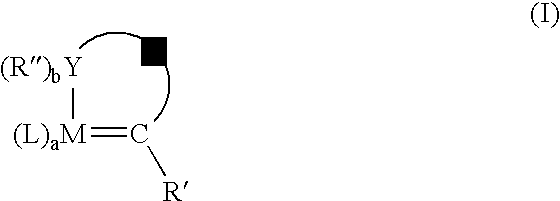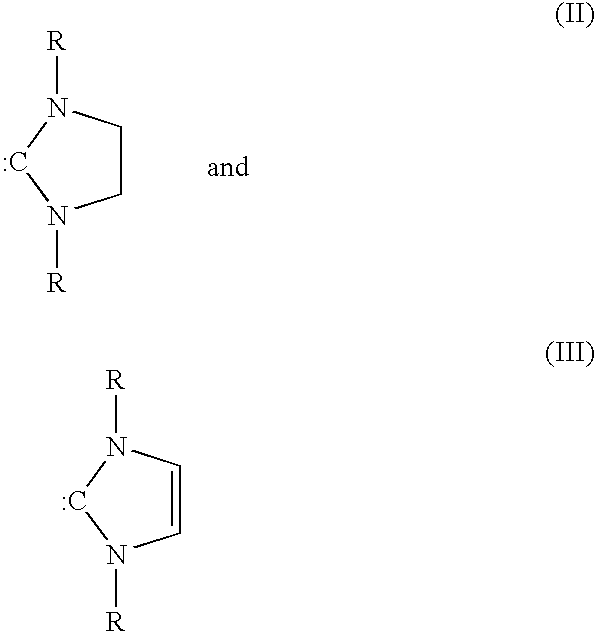Process for the synthesis of unsaturated alcohols
a technology of unsaturated alcohol and synthesis process, which is applied in the preparation of oxygen-containing compounds, organic chemistry, chemistry apparatus and processes, etc., can solve the problems of low practical application rate of catalyst turnover and achieve the effect of improving catalyst turnover number and improving yield of unsaturated alcohol products
- Summary
- Abstract
- Description
- Claims
- Application Information
AI Technical Summary
Benefits of technology
Problems solved by technology
Method used
Image
Examples
examples 7-12
Metathesis processes were conducted on methyl ricinoleate acetate in a manner similar to that of Examples 1-6, with the exception that a different set of catalysts was tested. The primary reaction products comprised 1-decene-4-acetate and methyl 9-decenoate. The 1-decene-4-acetate is deprotected as in Examples 1-6 to yield the homo-allylic mono-alcohol 1-decene-4-ol. The catalysts are illustrated hereinafter; and the process conditions and results are shown in Table 3.
C12GII-[(1,3-Bis-(2,4,6-trimethylphenyl)-2 imidazolidinylidene) dichloro(phenyl-methylene)-(tricyclohexylphosphine)ruthenium
Br2GII-[(1,3-Bis-(2,4,6-trimethylphenyl)-2 imidazolidinylidene) dibromo(phenyl-methylene)(tricyclohexylphosphine)ruthenium)]
12GII-[(1,3-Bis-(2,4,6-trimethylphenyl)-2 imidazolidinylidene) diiodo(phenylmethylene)-(tricyclohexylphosphine)ruthenium)]
C12GIIC-1,3-Bis-(2,4,6-trimethylphenyl)-2-imidazolidinylidene)dichloro(o-isopropoxyphenylmethylene)ruthenium
Br2GIIC-1,3-Bis-(2,4,6-trimethylpheny...
examples 13-15
were repeated, with the exception that no protection of the hydroxy functionality was employed. Thus, methyl ricinoleate was used in place of methyl ricinoleate acetate, and the general procedure for the metathesis process was as follows. An alumina-treated methyl ricinoleate (2.00 g; 5.60 mmol) was loaded into a glass vial with a stir bar and tetradecane (0.20 g) as an internal standard. To the glass vial, a toluene solution containing C12GII catalyst, [(1,3-Bis-(2,4,6-trimethylphenyl)-2 imidazolidinylidene) dichloro(phenyl-methylene)-(tricyclohexylphosphine)ruthenium, was added where the mole ratio of methyl ricinoleate to catalyst was varied from 5,000 to 100,000:1. Samples were removed at set intervals and quenched with excess butyl vinyl ether. Analysis was accomplished by GC to determine conversion of the methyl ricinoleate and total turnovers to dimethyl- 1,18-octadec-9-enedioate (moles of dimethyl-1,18-octadec-9-enedioate produced / mole catalyst). Results are presented in Tab...
PUM
| Property | Measurement | Unit |
|---|---|---|
| total pressure | aaaaa | aaaaa |
| total pressure | aaaaa | aaaaa |
| total pressure | aaaaa | aaaaa |
Abstract
Description
Claims
Application Information
 Login to View More
Login to View More - R&D
- Intellectual Property
- Life Sciences
- Materials
- Tech Scout
- Unparalleled Data Quality
- Higher Quality Content
- 60% Fewer Hallucinations
Browse by: Latest US Patents, China's latest patents, Technical Efficacy Thesaurus, Application Domain, Technology Topic, Popular Technical Reports.
© 2025 PatSnap. All rights reserved.Legal|Privacy policy|Modern Slavery Act Transparency Statement|Sitemap|About US| Contact US: help@patsnap.com



